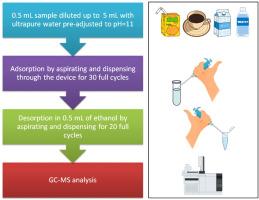Clove essential oil impregnated cellulose paper as a sustainable sorbent for rapid microextraction of sedative drugs in complex beverages matrices
IF 5.8
2区 化学
Q2 CHEMISTRY, MULTIDISCIPLINARY
引用次数: 0
Abstract
A novel disposable in-tip cellulose paper (DICP) device, functionalized with clove essential oil (CEO), was developed for the microextraction of five sedative and antihistaminic drugs viz. chlorpheniramine, pheniramine, ketamine, diazepam, and lorazepam; from beverages commonly encountered in drug-facilitated crimes (DFCs), including fruit juice, tea, milk, and water. The DICP device was fabricated by dip-coating cellulose paper (CP) with 2 % CEO (in hexane), cutting into rectangular strips, and inserting them into a 1000 μL micropipette tip. The extraction involved 30 aspiration–dispensing cycles for analyte adsorption, followed by 20 cycles for desorption using 0.5 mL ethanol. The method exhibited excellent linearity (0.1–5 μg mL−1; R2 > 0.994) with limits of quantification between 0.071 and 0.094 μg mL−1, accuracy ranging from 85.9 % to 111.9 %, and intra- and inter-day precision below 8.7 % and 14.7 % RSD, respectively. Matrix effects remained below 13 % across all beverage types. The extraction mechanism is based on hydrophobic, hydrogen bonding, and π–π interactions between CEO and the analytes. The DICP platform supports high-throughput operation (12 samples/hour) and requires no auxiliary equipment. It is also highly cost-effective, as a single cellulose disc (150 mm diameter) yields approximately 30 extraction strips. Green analytical performance metrics; CACI (85), ComplexMoGAPI (85), and AGREE (0.64); underscore the method's sustainability, simplicity, and practicality. Applicability was further demonstrated through blind sample analysis at multiple concentration levels, simulating real forensic scenarios and confirming the method's reliability and operational feasibility for routine casework.

丁香精油浸渍纤维素纸作为复合饮料基质中镇静药物快速微萃取的可持续吸附剂
采用丁香精油(CEO)功能化的一次性尖端纤维素纸(DICP)装置,对氯苯那敏、苯那敏、氯胺酮、地西泮和劳拉西泮5种镇静和抗组胺药物进行微萃取;从毒品促成犯罪(dfc)中常见的饮料中提取,包括果汁、茶、牛奶和水。DICP装置是在纤维素纸(CP)上浸涂2%的CEO(以己烷为溶剂),切成矩形条,插入1000 μL的微管针尖中制备的。提取过程包括30次抽吸-分配循环,用于分析物吸附,然后用0.5 mL乙醇进行20次解吸。方法线性良好(0.1 ~ 5 μ mL−1,R2 > 0.994),定量限在0.071 ~ 0.094 μ mL−1之间,准确度在85.9% ~ 111.9%之间,日内、日间精密度分别低于8.7%和14.7% RSD。所有饮料类型的基质效应都保持在13%以下。萃取机制是基于疏水,氢键和π -π相互作用的CEO和分析物。DICP平台支持高通量操作(12个样品/小时),不需要辅助设备。它也具有很高的成本效益,因为单个纤维素圆盘(直径150毫米)可以产生大约30条提取条。绿色分析性能指标;CACI (85), ComplexMoGAPI (85), AGREE (0.64);强调该方法的可持续性、简单性和实用性。通过多浓度水平下的盲样分析,模拟真实法医场景,进一步论证了该方法的适用性,验证了该方法在日常案件工作中的可靠性和操作可行性。
本文章由计算机程序翻译,如有差异,请以英文原文为准。
求助全文
约1分钟内获得全文
求助全文
来源期刊

Sustainable Chemistry and Pharmacy
Environmental Science-Pollution
CiteScore
8.20
自引率
6.70%
发文量
274
审稿时长
37 days
期刊介绍:
Sustainable Chemistry and Pharmacy publishes research that is related to chemistry, pharmacy and sustainability science in a forward oriented manner. It provides a unique forum for the publication of innovative research on the intersection and overlap of chemistry and pharmacy on the one hand and sustainability on the other hand. This includes contributions related to increasing sustainability of chemistry and pharmaceutical science and industries itself as well as their products in relation to the contribution of these to sustainability itself. As an interdisciplinary and transdisciplinary journal it addresses all sustainability related issues along the life cycle of chemical and pharmaceutical products form resource related topics until the end of life of products. This includes not only natural science based approaches and issues but also from humanities, social science and economics as far as they are dealing with sustainability related to chemistry and pharmacy. Sustainable Chemistry and Pharmacy aims at bridging between disciplines as well as developing and developed countries.
 求助内容:
求助内容: 应助结果提醒方式:
应助结果提醒方式:


